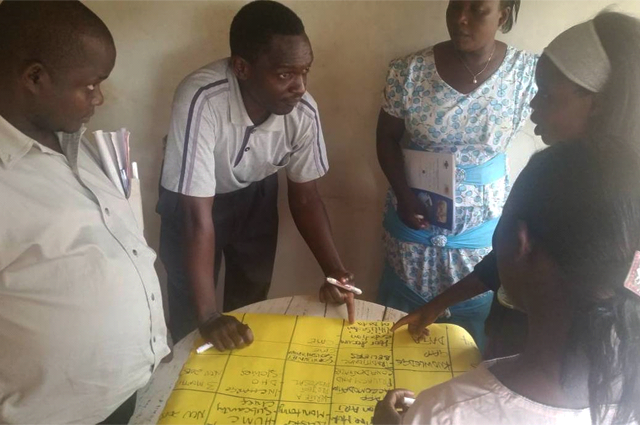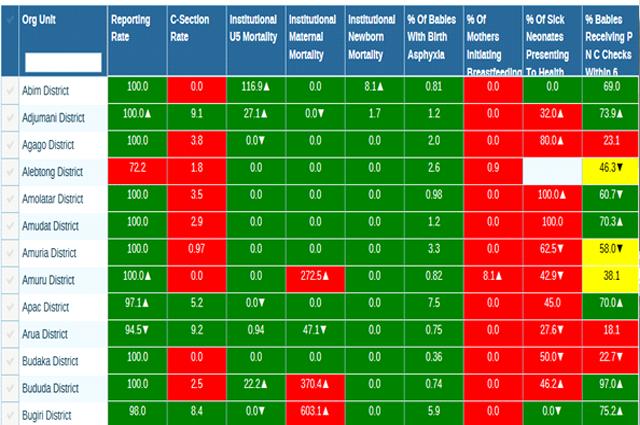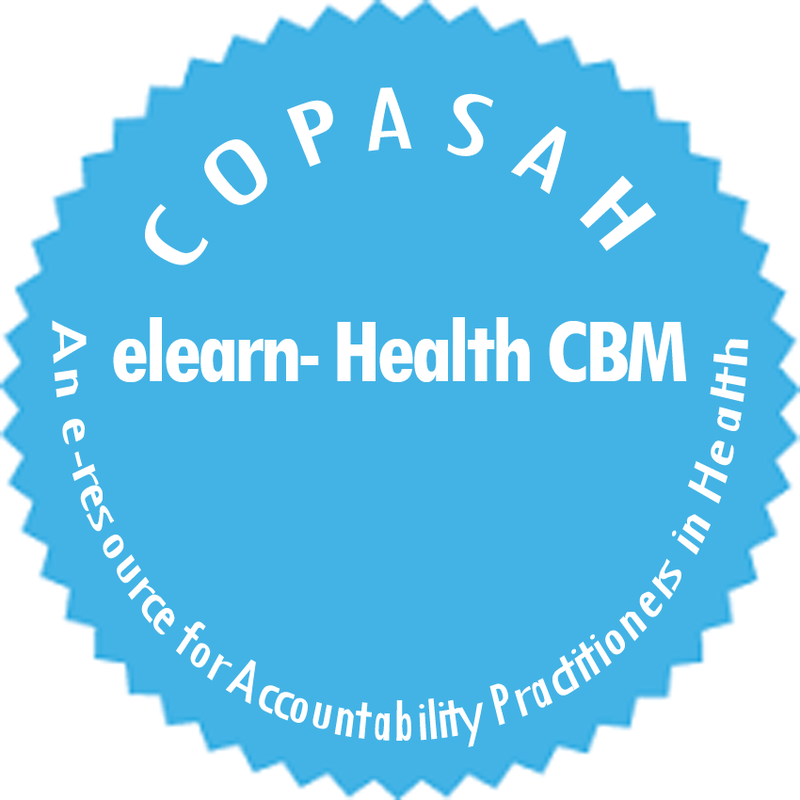
|
|
Launching of the Uganda Maternal Health Score Card - Towards
Transparency and Accountability
Transparency and Accountability
|
AZIZ AGABA
|
|
In November 2013, Uganda launched a health care plan- A Promise Renewed Sharpened and first Integrated Reproductive, Maternal, Newborn and Child Health (RMNCH) with clear goals, objectives, priorities and implemented five strategic shifts in order to employ new ways of combating RMNCH challenges. The plan aims to accelerate reduction in maternal, newborn and child mortality, to improve Uganda's RMNCH indicators by 2017. Health indicators with respective targets were identified to sharpen the plan. In order to track the progress against the ambitious goals and targets, the government had to invest in efforts to track performance.
Therefore, the endeavour of developing and implementing the Uganda RMNCH Scorecard is in line with global initiatives including the A Promise Renewed (APR)1, UN Commission on Information and Accountability among others. Under the APR initiative, the Ministry of Health progressively institutionalize a national and sub-national RMNCH scorecard based on routine Health Management Information System (HMIS) data and the District Health Information System (DHIS) platform. The Uganda integrated RMNCH proposes a quarterly dashboard monitoring system at the national level to compile data for scorecard in the first month of every quarter. This will also |
Staff and Management Committee of Bigasa HCIII convene to discuss the action plan during the training at the sub-county level in Bukomansimbi District
|
Based on The African Leaders Malaria Alliance (ALMA) Scorecard for Accountability and Action, the RMNCH scorecard is a mechanism through which decision makers, and other different stakeholders like community leaders, civil society organisations, etc. can track progress on RMNCH performance using metrics at different levels from national, regional, district and sub-district level. The scorecard represents an important tool for identifying locally owned and solutions to RMNCH performance issues. The Scorecard enables an action mechanism and progress tracking to facilitate comparisons across regions, districts and health facilities and to increase transparency and accountability around action. The Scorecard visually highlights specific RMNCH indicators that are doing well and areas experiencing bottlenecks and slower progress. Therefore, Uganda RMNCH scorecard presents an opportunity to:
Piloting the RMNCH Score Card
In order to achieve the desired outcomes like that of ensuring transparency, accountability around RMNCH etc., the RMNCH scorecard was subjected to a pilot exercise and concept demonstration was done in 13 districts i.e. Butambala, Bukomansimbi, Mukono, Tororo, Mbale, Kiboga, Kibale, Bundibugyo, Kabarole, Masaka, Busia, Hoima and Mubende across the different regions of Uganda to test the effectiveness and efficiency of its accountability mechanism.
During the pilot exercise, district teams composed of both technical and political officials including HIMS focal persons, Biostatistician, Records Assistants, and Health Facility In- charges, Community Development Officers among others at district, sub-county and community levels were oriented and trained on the scorecard. The district teams jointly generated multi-level scorecards from district to health centre II levels, drew action plans and assigned roles to appropriate accountability mechanisms. The Proof of Concept Demonstration (PoC) was carried out to test the efficiency and effectiveness of accountability mechanisms in responding to issues identified in the scorecards.
Performance review using the RMNCH scorecard selected accountability mechanisms
Depending on the organization unit or level of performance review, the review and interpretation of the RMNCH scorecard involved both direct and indirect technical personnel, politicians and development partners among others in the district. The process garnered high-level support at all levels. The target audience and platform had the potential to account for RMNCH performance at that level, make or influence decisions and follow up action items prioritized. The categories of the accountability mechanisms included sectoral committees, DHTs, sub-county level committees, HUMCs, community members.
Levels of engagement with accountability mechanisms
The PoC was conducted at three levels (categories) following the local government structure:
- Enhance transparency, accountability and action around RMNCH.
- Enable better profiling and monitoring of high-impact RMNCH interventions to help decision-makers identify and prioritise gaps.
- Facilitate and strengthen evidence-based action plans to improve internal management of programmes and policies.
- Serve as an advocacy tool for external partners and civil society organisations.
- Align priorities and actions with existing national review processes and timing.
- Validate and triangulate the implementation of actions intended to improve the health outcomes of women and children.
Piloting the RMNCH Score Card
In order to achieve the desired outcomes like that of ensuring transparency, accountability around RMNCH etc., the RMNCH scorecard was subjected to a pilot exercise and concept demonstration was done in 13 districts i.e. Butambala, Bukomansimbi, Mukono, Tororo, Mbale, Kiboga, Kibale, Bundibugyo, Kabarole, Masaka, Busia, Hoima and Mubende across the different regions of Uganda to test the effectiveness and efficiency of its accountability mechanism.
During the pilot exercise, district teams composed of both technical and political officials including HIMS focal persons, Biostatistician, Records Assistants, and Health Facility In- charges, Community Development Officers among others at district, sub-county and community levels were oriented and trained on the scorecard. The district teams jointly generated multi-level scorecards from district to health centre II levels, drew action plans and assigned roles to appropriate accountability mechanisms. The Proof of Concept Demonstration (PoC) was carried out to test the efficiency and effectiveness of accountability mechanisms in responding to issues identified in the scorecards.
Performance review using the RMNCH scorecard selected accountability mechanisms
Depending on the organization unit or level of performance review, the review and interpretation of the RMNCH scorecard involved both direct and indirect technical personnel, politicians and development partners among others in the district. The process garnered high-level support at all levels. The target audience and platform had the potential to account for RMNCH performance at that level, make or influence decisions and follow up action items prioritized. The categories of the accountability mechanisms included sectoral committees, DHTs, sub-county level committees, HUMCs, community members.
Levels of engagement with accountability mechanisms
The PoC was conducted at three levels (categories) following the local government structure:
- District and Health Sub District
- Sub-county
- Community level
|
Screen shot of the district scorecards as generated
from the National Health Information System |
limitations of time and there was an assumption that there is consensus amongst different health actors within the same category. District and Health Sub District are largely policy actors, sub-county actors are largely implementers and the communities are the beneficiaries/consumers.
At the sub-county level, the participants noted that enforcement of action plans could be done by ensuring that there exist jointly drawn schedules, duty rosters, monitoring schedules, and involvement of sub-county stakeholders. While at the district and health sub-district level, regular joint monitoring and supervision was suggested as a key component of enforcing actions generated from the accountability mechanisms. They further noted that training of the HUMCs and the sub-county officials in the use and application of the scorecard would help them to implement the actions by clarifying the systematic processes to undertake to address issues identified. |
At the community level, the communities suggested regular information and feedback from the sub-county headquarters and the health centres that serve them.
Launching the RMNCH Score Card at National Level
Following the completion of the PoC, the scorecard was launched on September 3 2015. During the launch, the UNHCO Executive Director, Robinah Kaitiritimba noted that UNHCO was selected to develop the scorecard owing to her previous experience in successfully implementing social accountability programs. She noted that UNHCO has been working with scorecards for quite a while especially at the community level – raising citizen awareness on rights and responsibilities.
“We are happy to say the (the first phase of the) scorecard process has been completed – we started off about a year ago. We thank World Vision for being the grant holder. Most importantly, we also thank Ministry of Health, UNFPA, UNICEF, WHO and the district stakeholders that have been very helpful – they are very excited about the opportunities and ease of work with data that the score card brings”.
“We started off with meetings to solicit system needs from various stakeholders. We discussed indicators – some of which are not monitored by the information system at the Ministry of Health at the moment. After we developed the indicators, we went back to the drawing board to develop the scorecard”.
“The team that is here is the one that has been at the centre of the development of the Score card. We appreciate the efforts you have put into its development”.
The development of the scorecard was done in a participatory, inclusive and consultative manner to include the district and national level stakeholders and health development partners. The Ministry of Health expects that the scorecard will galvanise and increase stakeholder collective performance assessment and support for quality RMNCH services for all Ugandans.
All actors (public sector, private sector, civil society development partners and donors) from all levels of policymaking, program management, service provision and community mobilisation were called upon to ensure sustainable access to RMNCH services in Uganda.
Launching the RMNCH Score Card at National Level
Following the completion of the PoC, the scorecard was launched on September 3 2015. During the launch, the UNHCO Executive Director, Robinah Kaitiritimba noted that UNHCO was selected to develop the scorecard owing to her previous experience in successfully implementing social accountability programs. She noted that UNHCO has been working with scorecards for quite a while especially at the community level – raising citizen awareness on rights and responsibilities.
“We are happy to say the (the first phase of the) scorecard process has been completed – we started off about a year ago. We thank World Vision for being the grant holder. Most importantly, we also thank Ministry of Health, UNFPA, UNICEF, WHO and the district stakeholders that have been very helpful – they are very excited about the opportunities and ease of work with data that the score card brings”.
“We started off with meetings to solicit system needs from various stakeholders. We discussed indicators – some of which are not monitored by the information system at the Ministry of Health at the moment. After we developed the indicators, we went back to the drawing board to develop the scorecard”.
“The team that is here is the one that has been at the centre of the development of the Score card. We appreciate the efforts you have put into its development”.
The development of the scorecard was done in a participatory, inclusive and consultative manner to include the district and national level stakeholders and health development partners. The Ministry of Health expects that the scorecard will galvanise and increase stakeholder collective performance assessment and support for quality RMNCH services for all Ugandans.
All actors (public sector, private sector, civil society development partners and donors) from all levels of policymaking, program management, service provision and community mobilisation were called upon to ensure sustainable access to RMNCH services in Uganda.
ABOUT THE AUTHOR
Aziz Agaba is working as a Programme Officer with UNHCO.UNHCO is a membership non-governemental organisation working in Uganda. Since its inception in 1999, UNHCO has been implementing programmes that advocate for a strong institutionalized platform that is able to articulate voices of consumers of health goods and services. UNHCO has championed the Rights Based Approach (RBA) to healthcare delivery and contributed to efforts to improve community participation and accountability. For more information on UNHCO, Pls visit: www.unhco.or.ug
Aziz Agaba is working as a Programme Officer with UNHCO.UNHCO is a membership non-governemental organisation working in Uganda. Since its inception in 1999, UNHCO has been implementing programmes that advocate for a strong institutionalized platform that is able to articulate voices of consumers of health goods and services. UNHCO has championed the Rights Based Approach (RBA) to healthcare delivery and contributed to efforts to improve community participation and accountability. For more information on UNHCO, Pls visit: www.unhco.or.ug










